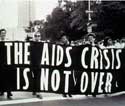memory
A Gift of Flowers
Katya, of non-profit marketing blog, spotted this in the lobby of a tony midtown office building:

It’s a nice gesture — and I’m certainly going to think of this wherever I see those red flowers this season.
Sir! No Sir!
 From Peter Linebaugh in CounterPunch:
From Peter Linebaugh in CounterPunch:
“On the 11th hour of the 11th day of the 11th month the Great Powers of the World signed the armistice laying down arms after four years of the bloodiest war in history. That was 1918.
Now, we call it Veteran’s Day.
What caused the armistice was the refusal of soldiers to fight. They refused ‘to go over the top’ anymore. In Russia, France, England, Italy they refused to participate in the slaughter which had begun in 1914.
What we learn from Armistice Day is that the soldier is the front line of the peace movement.”
GI refusal also helped end the war in Vietnam, and it’s spreading in Iraq and Afghanistan, too, encouraged by veterans speaking out.
 Visual AIDS has posted a small gallery of typographically-driven work from artists with HIV. In context, some of the images are quite devastating. Here’s the curator’s statement.
Visual AIDS has posted a small gallery of typographically-driven work from artists with HIV. In context, some of the images are quite devastating. Here’s the curator’s statement. Memorial Day

Source: http://www.armytimes.com/news/2010/04/military_veterans_suicide_042210w/
While there may not be so many “unknown soldiers” any more, it seems like there are more and more forgotten ones in our midst.
Howard Zinn
Yesterday, Howard Zinn passed away. A former World War II bombardier turned life-long activist, teacher, and radical historian, Zinn inspired and touched the lives of many. His watershed book A People’s History of the United States told the stories of atrocities and brutality, activism and organizing often ignored by mainstream accounts of US history. His anthology of primary sources, Voices of a People’s History of the United States led to the founding of a non-profit organization that holds dramatic readings of the works across the US: “By giving public expression to rebels, dissenters, and visionaries from our past—and present—VOICES seeks to educate and inspire a new generation working for social justice.”
Democracy Now! aired an hour-long tribute this morning. If you subscribe to Netflix, you can watch this documentary on his life and work. There’s more audio, video, and text at howardzinn.org.
One Thousand Paper Cranes
 Sadako Sasaki was two years old when she survived the atomic bomb dropped on Hiroshima on August 6. 1945. Ten years later, she became gravely ill and was hospitalized with leukemia. She began folding paper cranes in hope of making a thousand, which according to Japanese legend would allow her to be granted one wish — to live. However, when she realized she would not survive, she wished instead for world peace and an end to suffering.
Sadako Sasaki was two years old when she survived the atomic bomb dropped on Hiroshima on August 6. 1945. Ten years later, she became gravely ill and was hospitalized with leukemia. She began folding paper cranes in hope of making a thousand, which according to Japanese legend would allow her to be granted one wish — to live. However, when she realized she would not survive, she wished instead for world peace and an end to suffering.
She folded 644 cranes before she became too weak to fold any more, and died shortly after. Sadako’s story has been popularized in books, movies, and music, including a widely translated children’s book in 1965 by an Austrian author and the American children’s book Sadako and the Thousand Paper Cranes published in 1977.
The origami paper crane has since become a symbol of world peace. Paper cranes and lanterns are floated each year to remember those who died from the bombs and to call for peace and disarmament.
Placeholder
From wikipedia:
The art students who created the [Goddess of Democracy] statue wrote a declaration that said in part:
“At this grim moment, what we need most is to remain calm and united in a single purpose. We need a powerful cementing force to strengthen our resolve: That is the Goddess of Democracy. Democracy… You are the symbol of every student in the Square, of the hearts of millions of people.… Today, here in the People’s Square, the people’s Goddess stands tall and announces to the whole world: A consciousness of democracy has awakened among the Chinese people! The new era has begun! …
The statue of the Goddess of Democracy is made of plaster, and of course cannot stand here forever. But as the symbol of the people’s hearts, she is divine and inviolate. Let those who would sully her beware: the people will not permit this! …
On the day when real democracy and freedom come to China, we must erect another Goddess of Democracy here in the Square, monumental, towering, and permanent. We have strong faith that that day will come at last. We have still another hope: Chinese people, arise! Erect the statue of the Goddess of Democracy in your millions of hearts! Long live the people! Long live freedom! Long live democracy!”
The document was signed by the eight art academies that sponsored the creation of the statue: The Central Academies of Fine Arts, Arts and Crafts, Drama, and Music; the Beijing Film Academy; the Beijing Dance Academy; the Academy of Chines Local Stage Arts; and the Academy of Traditional Music.
The entire statement was written on a long banner placed near the statue, and was read in its entirety by a female student “with a good Mandarin accent” from the Broadcasting Academy.
Think of the Children
In my bloggy readings, I keep finding stories of monuments and memorials sold on infantilism, using the lens of “childhood” to conjure an air of authenticity and gravitas.
 The New Yorker on Santiago Calatrava:
The New Yorker on Santiago Calatrava:
“In Liège, Belgium, Calatrava was one of seven contestants in an architectural competition to design a high-speed-train station. His rivals came in teams, armed with examples of their past work; Calatrava showed up alone, with his paintbrush [and watercolors], and won the commission. In January, 2004, while presenting his proposal for a new PATH transit hub for the World Trade Center site, Calatrava drew in chalk a child releasing a bird from her hands, thus conveying the genesis of the design, in which a pair of glass-and-steel canopies would arch over the sidewalks of lower Manhattan, like outstretched wings.”
The Washington Post on Ralph Appelbaum:
“When he took on the task of designing a presidential library for former Nigerian president Olusegun Obasanjo, for example, he proposed focusing the displays on the question, ‘What does it take to make a Nigerian child?’ It’s an unanswerable question, but it provided the necessary aha moment that made it all come together, a positive theme that finesses some of the philosophical problems of a presidential library in a country riven by corruption, violence, and religious, ethnic, linguistic and economic divisions.”
The Independent on Daniel Libeskind and his World Trade Center design:
“But Libeskind, a Polish American who now lives in Berlin, captured the hearts of New Yorkers when he appeared live on CNN during the final stages of the competition and said: ‘Like so many others, I arrived by ship in New York harbour as a teenager and as an immigrant. The Statue of Liberty and the Manhattan skyline made an unforgettable impression, and this scheme is all about that.’ ‘The minute he said that, he had the job,’ says Doris Saatchi, the New York art collector. ‘It’s not showmanship. He just expresses emotion so well.’”
Meanwhile, actual kids are moving adults to make responsible policy. See Democracy Now!: Testimony of 12-Year-Old with Two Moms Moves Some Vermont Legislators to Support Gay Marriage Bill.
Crosswalk Memorial
This YouTube video documents pedestrian advocates in Lisbon, Portugal replacing the white “zebra” stripes in a crosswalk with the stenciled names of 137 pedestrians killed by cars. On the curb, the tagline reads: “1/4 das vítimas de acidentes de automóvel são peões.” 1/4 of the victims of automoboile accidents are pedestrians.
The typographic crosswalks were installed in May 2007 at four locations by the ad agency DraftFCB Lisbon for the advocacy group Associação de Cidadãos Auto-Mobilizados with support from Liberty Insurance and JC Decaux. The action generated a bit of media attention to the issue during “Safe Street Week.” (via)

